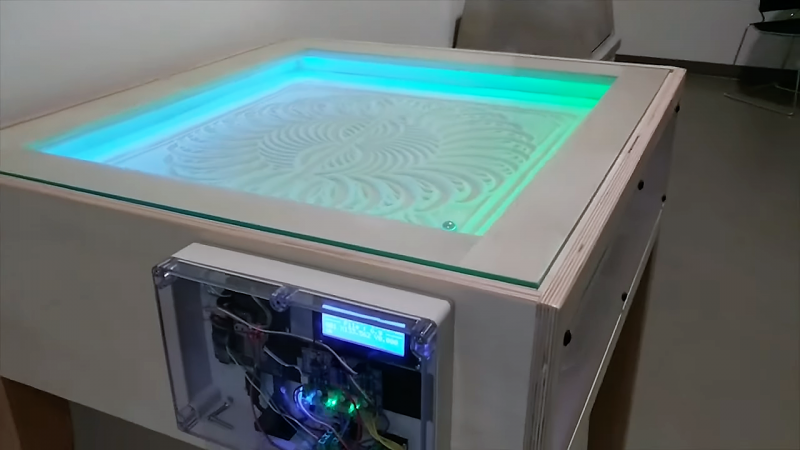The purpose of a Zen garden, those stylized landscapes created by painstakingly placing rocks and raking gravel into perfect patterns, is the doing of the thing. Making sure every line is perfectly formed is no mean feat, and the concentration required to master it is the point of the whole thing. But who has time for that? Why not just build a robot to create the perfect Zen garden in miniature?
That was what [Tim Callinan] and his classmates did for a semester project, and the “ZenXY” sand plotter was the result. There isn’t a build log for the device per se, although the video below makes it plain how they went about this. The sand table itself is a plywood box whose bottom is layered with fine white sand and contains a single steel ball. Below the table is an X-Y gantry carrying a powerful magnet. A gShield riding on top of an Uno turns G code into slow, stately movement of the ball through the sand. The patterns are remarkably intricate, and while it might not be the same as mastering the body control needed to rake gravel with precision, watching the ball push the sand around is pretty Zen all by itself
This isn’t the first time we’ve seen someone try to automate a traditional Japanese practice. This tea ceremony robot comes to mind, and this nicely crafted sand table is very similar to the ZenXY.
[baldpower] tipped us off to this one.
















Hooray sandify!
Couldn’t have done it without your work, every pattern we use was generated or converted on sandify.
How does he get the sand flat again?
Why do you need to get the sand flat? Just roll a new design over the top of the old one.
Eventually the sand will migrate out to the sides, but a inwards spiral shape could pull it back.
Hey I’m one of the students that worked on this project, just saying that’s exactly what we do and it creates even more complex designs by layering.
Still the most common question we get is “how do you clear it”.
you turn the table upside down and shake it
Could be done with a 555: attach a metal plate to an exciter and use the 555 to create a Chladni plate. :)
Check The Art of Motion Control by Dave Shapiro. This guy was making these machines like 20+ years ago (very inspiring). He should be credited for the egg plotter, bubble displays and a couple other things.
BRUCE Shapiro
Link, for lazy folk, to Bruce’s 2016 Sysiphus project:
http://www.taomc.com/sisyphus/
Duh, Sisyphus. Inexcusable, given the link contains the correct spelling. I plead the Christmas Defence.
I’ve got a Sisyphus coffee table, and it really is the ultimate in conversation-piece furniture.
It’s nice to see the concept done as a linear control build, as well!
It is nice to have the windows to see the mechanism, but it would be cool to hide it and the controller, and let guests wonder what is making the ball move. (If it is quiet enough, but if it isn’t quiet, is it really Zen?)
It’s quiet enough for it’s environment in a college. There’s no completely silencing stepper motors though. Letting passersby see the man-behind-the-curtain was the whole point as we wanted to show what mechatronics is all about and generate some interest in the program and the college.
Programming one of these things – eg finding an elegant algorithithm for a complex pattern – is itself pretty Zen.
Röyksopp! :-)
Yep! Leave it to a bunch of engineering students to incredibly over-engineer something like this! Linear rail to mount the linear rails on? 3 rails to run 1 axis on? I bet those sand patterns are accurate to 0.001 inch!
Ok, in all seriousness, you guys did a great job! And it is a fantastic display piece for the college and the course. I know what it takes to build a sand table from scratch because I’m a little more than half way through my build. Congratulations on a project well done!